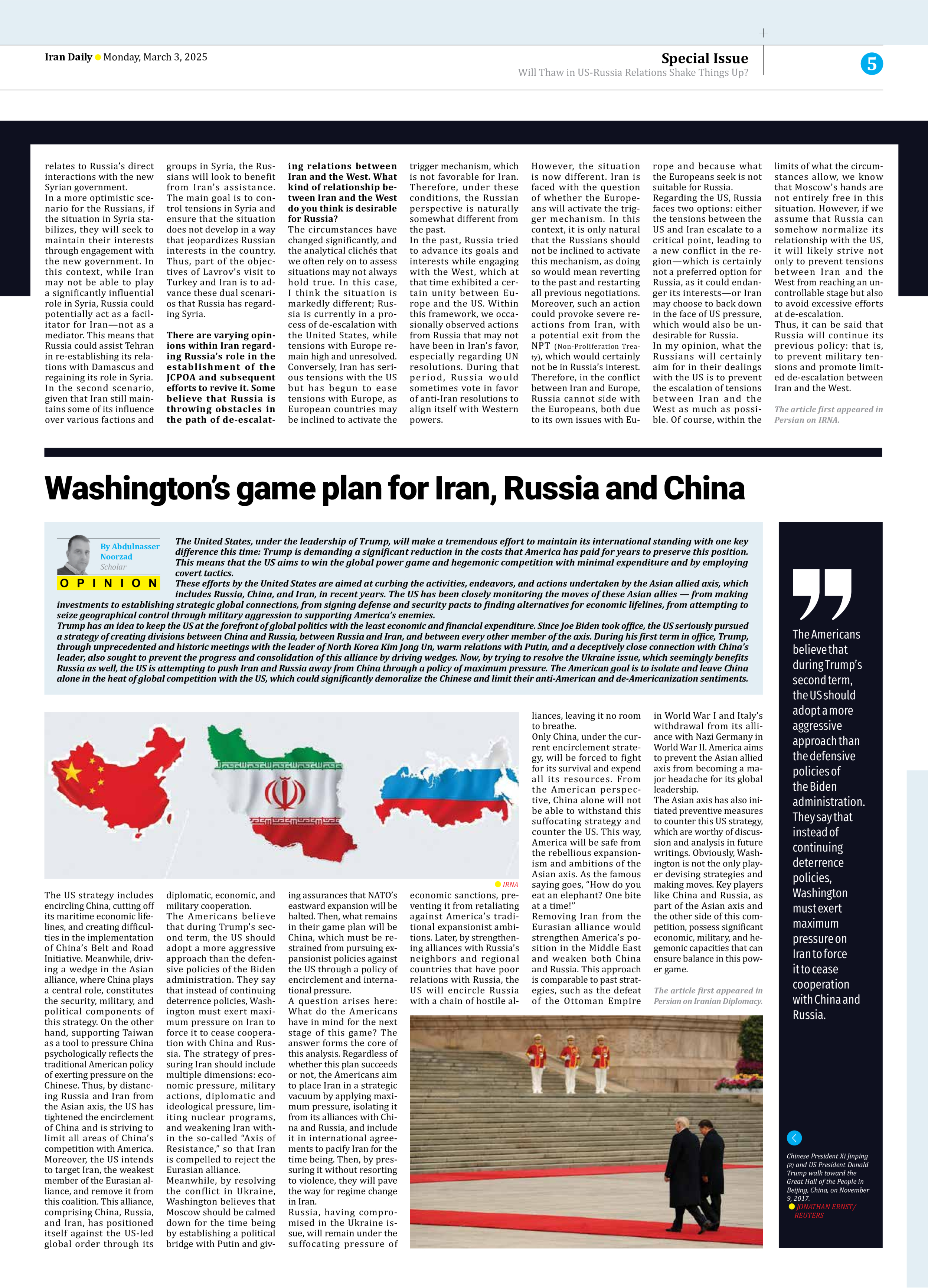
Washington’s game plan for Iran, Russia and China
The United States, under the leadership of Trump, will make a tremendous effort to maintain its international standing with one key difference this time: Trump is demanding a significant reduction in the costs that America has paid for years to preserve this position. This means that the US aims to win the global power game and hegemonic competition with minimal expenditure and by employing covert tactics. These efforts by the United States are aimed at curbing the activities, endeavors, and actions undertaken by the Asian allied axis, which includes Russia, China, and Iran, in recent years. The US has been closely monitoring the moves of these Asian allies — from making investments to establishing strategic global connections, from signing defense and security pacts to finding alternatives for economic lifelines, from attempting to seize geographical control through military aggression to supporting America’s enemies. Trump has an idea to keep the US at the forefront of global politics with the least economic and financial expenditure. Since Joe Biden took office, the US seriously pursued a strategy of creating divisions between China and Russia, between Russia and Iran, and between every other member of the axis. During his first term in office, Trump, through unprecedented and historic meetings with the leader of North Korea Kim Jong Un, warm relations with Putin, and a deceptively close connection with China’s leader, also sought to prevent the progress and consolidation of this alliance by driving wedges. Now, by trying to resolve the Ukraine issue, which seemingly benefits Russia as well, the US is attempting to push Iran and Russia away from China through a policy of maximum pressure. The American goal is to isolate and leave China alone in the heat of global competition with the US, which could significantly demoralize the Chinese and limit their anti-American and de-Americanization sentiments.
By Abdulnasser Noorzad
Scholar
The US strategy includes encircling China, cutting off its maritime economic lifelines, and creating difficulties in the implementation of China’s Belt and Road Initiative. Meanwhile, driving a wedge in the Asian alliance, where China plays a central role, constitutes the security, military, and political components of this strategy. On the other hand, supporting Taiwan as a tool to pressure China psychologically reflects the traditional American policy of exerting pressure on the Chinese. Thus, by distancing Russia and Iran from the Asian axis, the US has tightened the encirclement of China and is striving to limit all areas of China’s competition with America. Moreover, the US intends to target Iran, the weakest member of the Eurasian alliance, and remove it from this coalition. This alliance, comprising China, Russia, and Iran, has positioned itself against the US-led global order through its diplomatic, economic, and military cooperation.
The Americans believe that during Trump’s second term, the US should adopt a more aggressive approach than the defensive policies of the Biden administration. They say that instead of continuing deterrence policies, Washington must exert maximum pressure on Iran to force it to cease cooperation with China and Russia. The strategy of pressuring Iran should include multiple dimensions: economic pressure, military actions, diplomatic and ideological pressure, limiting nuclear programs, and weakening Iran within the so-called “Axis of Resistance,” so that Iran is compelled to reject the Eurasian alliance.
Meanwhile, by resolving the conflict in Ukraine, Washington believes that Moscow should be calmed down for the time being by establishing a political bridge with Putin and giving assurances that NATO’s eastward expansion will be halted. Then, what remains in their game plan will be China, which must be restrained from pursuing expansionist policies against the US through a policy of encirclement and international pressure.
A question arises here: What do the Americans have in mind for the next stage of this game? The answer forms the core of this analysis. Regardless of whether this plan succeeds or not, the Americans aim to place Iran in a strategic vacuum by applying maximum pressure, isolating it from its alliances with China and Russia, and include it in international agreements to pacify Iran for the time being. Then, by pressuring it without resorting to violence, they will pave the way for regime change in Iran.
Russia, having compromised in the Ukraine issue, will remain under the suffocating pressure of economic sanctions, preventing it from retaliating against America’s traditional expansionist ambitions. Later, by strengthening alliances with Russia’s neighbors and regional countries that have poor relations with Russia, the US will encircle Russia with a chain of hostile alliances, leaving it no room to breathe.
Only China, under the current encirclement strategy, will be forced to fight for its survival and expend all its resources. From the American perspective, China alone will not be able to withstand this suffocating strategy and counter the US. This way, America will be safe from the rebellious expansionism and ambitions of the Asian axis. As the famous saying goes, “How do you eat an elephant? One bite at a time!”
Removing Iran from the Eurasian alliance would strengthen America’s position in the Middle East and weaken both China and Russia. This approach is comparable to past strategies, such as the defeat of the Ottoman Empire in World War I and Italy’s withdrawal from its alliance with Nazi Germany in World War II. America aims to prevent the Asian allied axis from becoming a major headache for its global leadership.
The Asian axis has also initiated preventive measures to counter this US strategy, which are worthy of discussion and analysis in future writings. Obviously, Washington is not the only player devising strategies and making moves. Key players like China and Russia, as part of the Asian axis and the other side of this competition, possess significant economic, military, and hegemonic capacities that can ensure balance in this power game.
The article first appeared in Persian on Iranian Diplomacy.







